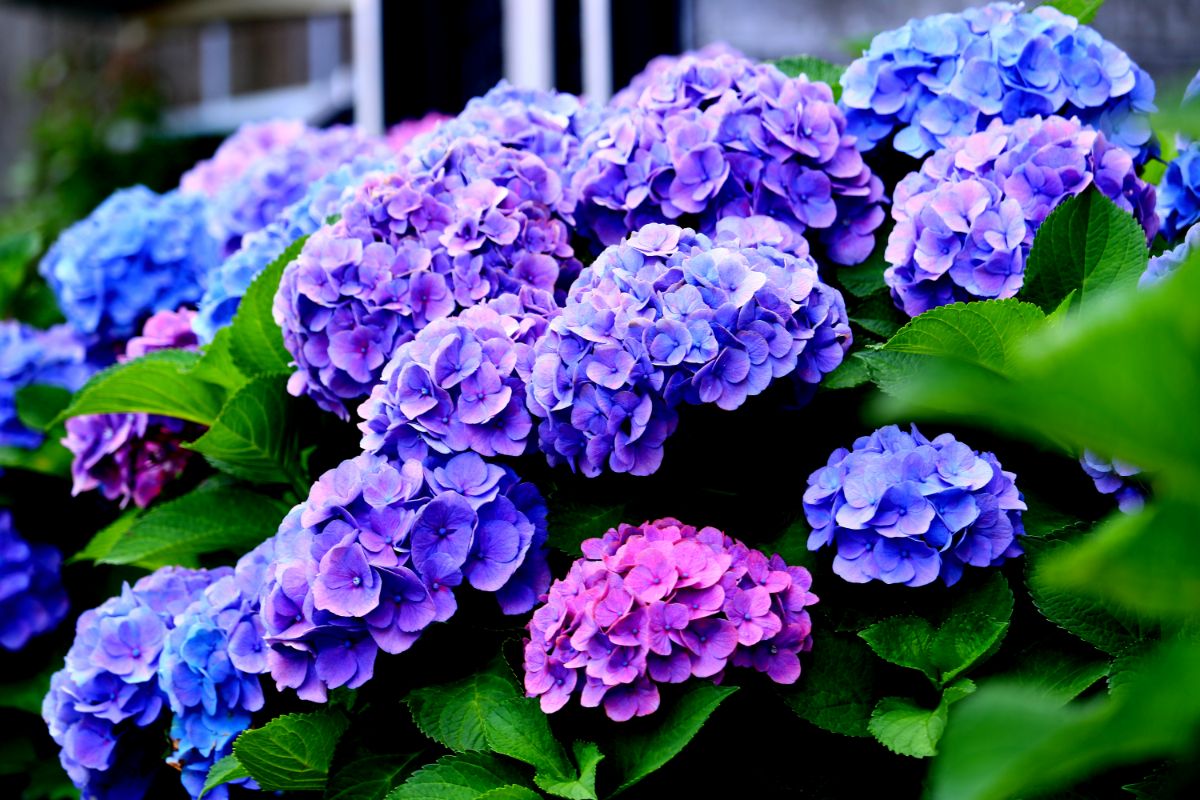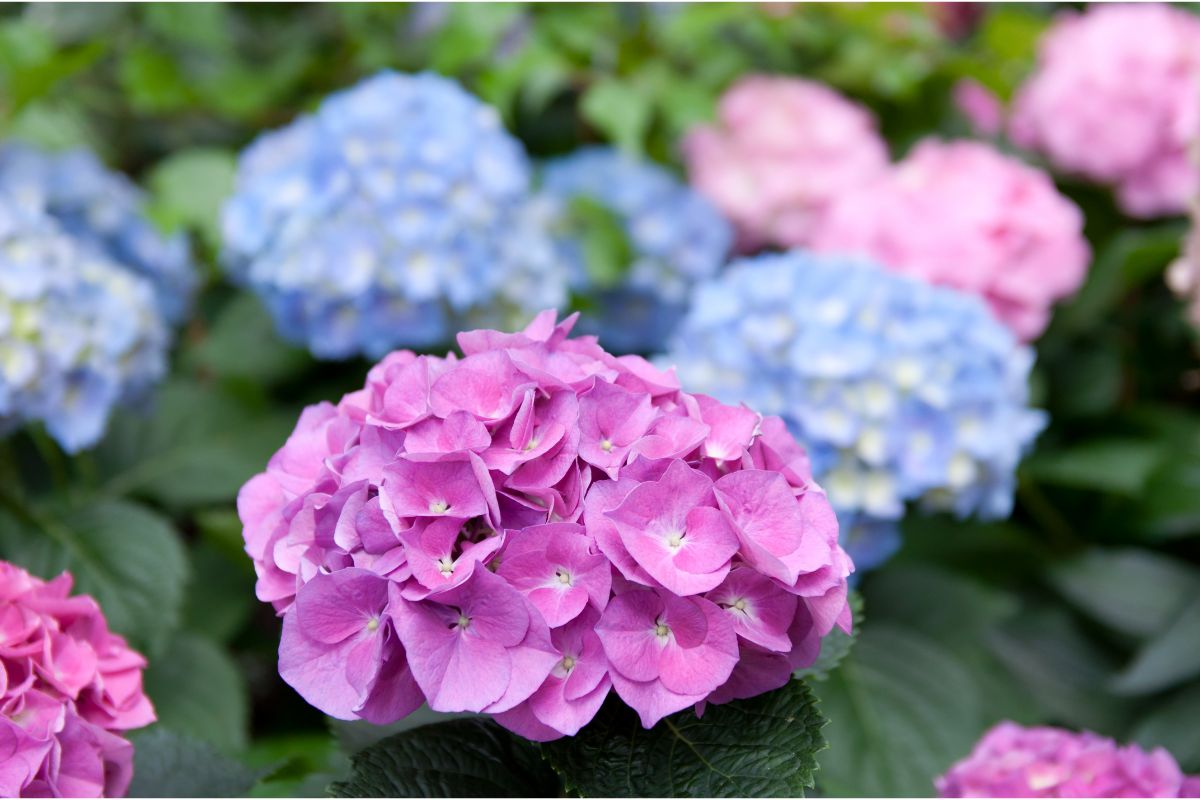Hydrangeas are known for their large blooms in gorgeous shades of purple, magenta, and pink.

If you’re thinking about planting these unique blooms in your backyard, you’ll need to know if they’ll need replanting after the growing season, or if they’ll keep growing back every year.
This raises the issue, are hydrangeas annuals or perennials?
In short, the answer is that hydrangeas can be both, based on your location’s hardiness zone.
You’ll find out more about whether hydrangeas are perennial or annual in this post, as well as whether you can grow them indoors.
Keep reading to find out more about hydrangeas!
The Difference Between Annual and Perennial Plants
Before we get into hydrangeas themselves, we need to cover what the terms annual and perennial mean.
Perennial
Perennial plants will live for over two years. If the plant is cold hardy, its top growth will die back with winter frost, then return when spring comes around.
If they form in optimal conditions, perennial plants can have a long lifespan. This is a large group of plants and each example has its own maintenance requirements.
Perennials are ideal for home propagation. You can choose to gather cuttings and plant them in growing material, or layer them straight in your backyard.
Dividing is also a nice way to reap additional perennials. Your garden will keep on growing if you do this in the fall or spring.
Annual
Annual plants will finish their entire life cycle inside a single growing season.
Seed germination, seed production, and death all occur in one cycle. Annual plants aim to keep producing seeds, as this ensures they can keep reproducing.
Annual plants will bloom throughout the season until they finish their job. You can improve their flowering time by deadheading the plants until the end of the season, when the first frost occurs.
Keep in mind that several plants can be annuals in a particular hardiness zone, but perennial in a different one.
Colder climates can be particularly rough, which isn’t ideal for plants that prefer hotter climates. You may notice a plant growing as a perennial in southern locations, but it can only work as an annual in northern climates.
Hydrangeas Hardiness Zones
A plant’s hardiness involves how well it can handle detrimental growing conditions, particularly its capability to survive harsh winters.
A lot of hydrangeas are hardy between USDA zones 3 to 7, but a few of these remain hardy as far as zone 9. Some prefer colder climates, while others like the shade.
This indicates that the majority of hydrangeas can handle colder winters and flower well the following season.
What Are Hydrangeas, Perennials, or Annuals?
Hydrangeas are all perennials. Every hydrangea will need more than a single season to finish its life cycle.
If you grew a hydrangea from its seeds, you’d need to wait between two and three years to see it bloom.
Additionally, hydrangeas are woody perennial plants. This indicates that their stalks aren’t the soft green ones you are used to. Tender perennials will usually die back during winter, but woody perennials are more resilient.
An exception here is the big leaf hydrangea. This type doesn’t handle zone 5 conditions well unless it’s grown in a container and moved indoors come wintertime.
This explains why some hydrangeas are thought to be annuals. These, like the big leaf hydrangea, aren’t cold tolerant in zone 5. They will die off during the winter frost and will struggle to return in spring.
It’s hard to keep hydrangeas grown in greenhouses alive, but this isn’t due to their cold-tolerant qualities.
The reason here is that these hydrangeas are grown in small containers. These can turn rapidly turn dry, leading to the plants becoming dehydrated.
As a result, if you do receive a gift hydrangea, move it to a larger container. Always use well-draining potting material and keep the soil damp, but not waterlogged.
Hydrangeas can live for as many as fifty years, provided they are looked after and receive enough sunlight.
Treating Plants As Annuals
Some may choose to treat a hydrangea as an annual.
If you select a hydrangea that’s not adapted to your location’s climate, you’ll probably have an annual hydrangea on your hands. If this is the case, your plant won’t survive the winter.
Many annual plants are grown in containers or window boxes. This is a location where you can treat the hydrangea like an annual plant.
Little hydrangea containers are available at garden centers and florists, which are perfect for dressing up window boxes.
This is also a nice tip if you like the way hydrangeas look, but don’t have the room needed to plant them in your backyard.
Keep in mind that we wouldn’t advise disposing of hydrangeas when the growing season finishes, as you can repurpose them in your backyard.
However, if you do buy a greenhouse-grown hydrangea, the plant may not return the following year. This is because of the differences in living and growing climates.
Can Potted Hydrangeas Handle Winter?
Potted hydrangeas that aren’t cold-tolerant will not live through winter when kept outdoors. These plants need to be taken inside, away from frost and icy winds.
However, transporting them inside means that you need to avoid keeping them in a hot room. These need to be kept in a cold environment, with a temperature around 45°F.
This is because hydrangeas need some cold in the wintertime to become dormant. If the plant doesn’t have the chance to turn dormant, it will gradually lose its vitality and start to die.
Will Hydrangeas Lose Leaves During Winter?
Hydrangeas will lose their leaves in winter, but this begins in the fall as the temperature turns colder. Come winter, the plants will have completely lost their leaves, looking as though they have died.

Hydrangeas lose their leaves during winter, but their stems remain intact. When spring comes around, they generate new growths, then buds and flowers.
This cycle continues again for many seasons.
If your location’s temperature doesn’t fall under 0°F, you won’t need to be concerned with establishing winter defense for your hydrangeas.
However, if you need to give your hydrangeas some winter protection, think about insulation materials. Arrange a wire cage and put down layers of pine straw, dry leaves, and hay.
Coat the roots with a dense compost layer.
Don’t take off any insulation materials before the final winter frost. An early spring frost may occur, taking you by surprise and harming your new growth.
If a later frost does occur once you’ve removed the insulation, use burlap, blankets, and additional insulation materials to shroud the shrub. Cover this fully, all the way to the ground.
Can Hydrangeas Grow Inside?
Hydrangeas thrive best outdoors, so indoor growing isn’t the best idea.
Hydrangeas either prefer partial shade or full sunlight, depending on the type of hydrangea. They develop better when they are grown in a garden environment.
If they are only grown indoors, the plants can experience several issues, like dehydration, vitality loss, and eventually death.
If you are growing hydrangeas indoors, here are some tips to help you increase the likelihood of the plant surviving.
- If your hydrangea is grown in a small container, transplant it to a bigger pot. This will prevent the potting mix from drying out rapidly, keeping the soil damp to hydrate the hydrangea.
- Use well-draining, nutrient-rich potting material.
- Keep the hydrangea in a bright location that receives lots of sunlight, but keep it away from direct sunlight.
- Keep up with regular watering and increase humidity levels if the air turns too dry inside.
- Use a fertilizer that’s specifically designed for acid-loving plants.
- Keep the hydrangeas in a cold room during winter, around 45°F.
- For the remaining seasons, keep the hydrangeas in temperatures 50°F and 60°F.
Hydrangeas can struggle to bloom inside, but you can encourage flowering by changing the temperature conditions. This makes the plant believe winter is on its way, triggering dormancy.
You may also be able to create a system where you move the hydrangeas outside in spring, summer, and fall, then keep them in a cold room inside, like the garage, in winter.
Final Thoughts
Hydrangeas are perennial plants that turn dormant in wintertime, then return to life during spring.
The things you do to protect your hydrangea from the frosty season will affect how well it can do in the following growing season.
If your location doesn’t experience frosty winters, and you have a cold-tolerant hydrangea, you won’t need to do much. As spring comes around, you’ll notice your hydrangeas returning, with attractive blooms and impressive foliage.
- Interesting Flowers That Start With A - July 21, 2023
- Interesting Flowers Beginning With H - July 21, 2023
- 14 Fascinating Flowers That Begin With C - July 20, 2023
